Ministry of Defence’s Science and Technology portfolio
Updated 6 December 2024
Introduction
The Defence Science and Technology Portfolio is a series of programmes and standalone projects designed to meet the Ministry of Defence (MOD)’s capability needs and to ensure the UK armed forces remain at the cutting edge of technology.
This guide gives an overview of each programme and standalone project for the benefit of industry, academia, other government and non-government organisations and partners.
To deliver on the scale and ambition set out by the MOD’s Chief Scientific Adviser will require a whole-of-UK effort as well as collaboration and cooperation from international allies.
Sustaining strategic advantage through science and technology (S&T) is the first objective of the UK’s combined security, defence, development and foreign policy.
The coming decade will see the ability to advance and exploit science and technology as an increasingly important metric of global power and an essential driver of economic, political, and military competition.
Thus, sustaining the UK’s status of a science and technology superpower and retaining these associated advantages is crucial for our national security and prosperity.
Over the next 4 years, the MOD will invest at least £6.6 billion in research and development (R&D) and this Science and Technology Portfolio will ensure defence sustains operational advantage, can make the right decisions, and generate prosperity for the UK.
Predominantly, the following programmes and projects will be delivered by the Defence Science and Technology Laboratory (Dstl), but partners in industry and academia will be crucial to delivery with significant funding available and opportunities to collaborate.
The portfolio has been designed by Defence Science and Technology in partnership with our stakeholders to ensure MOD’s science and technology activities:
- address defence’s capability priorities
- enable a decisive UK technological edge
- allow defence to understand the future
- sustain sovereign and critical capabilities
- balance challenge-driven research with exploratory research
Notably, this portfolio pivots emphasis in science and technology towards key capability challenges and high-risk generation-after-next research in emerging and little understood technologies as highlighted in the MOD’s Science and Technology Strategy 2020.
Generation-after-next and defence’s enduring science and technology challenges
Generation-after-next
Generation-after-next is capability that does not exist and contributing technology is not fully understood.
Concepts will be ‘leap ahead’ and world leading to challenge the boundaries of current and emerging understanding.
Defence’s enduring science and technology challenges
1. Pervasive, full spectrum, multi domain intelligence, surveillance and reconnaissance (ISR)
Respond to threats and opportunities of emerging technologies affecting our ability to conduct ISR in all domains and environments through affordable resilient solutions.
2. Multi-domain command and control, communications and computers (C4)
Develop the capability for multi-domain integration and ability to coordinate effects globally enabling us to execute joint operations against adversaries with well integrated and resilient capabilities.
3. Secure and sustain advantage in the subthreshold
Improve the UK’s ability to compete against adversaries below the threshold of conventional conflict and address our vulnerabilities, especially in the information environment.
4. Asymmetric hard power
Develop highly capable systems to target adversaries in new ways across all domains; develop novel means of delivery of hard power and effective protection against highly capable adversaries.
5. Freedom of access and manoeuvre (FOAM)
Generate affordable, survivable capability responsive to rapidly evolving threats operated within a denied electromagnetic environment and be interoperable with our allies and partners.
Further strategic context can be found in the MOD’s Science and Technology Strategy.
Programmes
The following sections cover 25 programmes within the Defence Science and Technology Portfolio that have significant funding and collaborative opportunities for industry and academia.
1. Advanced Materials

Welding
Vision
As the focal point for defence’s science and technology investment in materials science, exploit global developments and innovation in materials science to enable UK defence and security to maintain strategic and operational technological advantage.
Technical challenges
The Advanced Materials Programme will primarily focus on ‘technology push’ in 3 key areas. Technology push is an essential aspect of research in new technology to drive the development of new products.
The areas are:
- low observable materials
- materials for extreme physical environments subject to any of:
- extremes of temperature, including in oxidising environments
- polar to tropical operations and associated environmental challenges
- vibration and fatigue, impact and shock
- radiation, vacuum (for example outgassing)
- water depth
- erosion and accretion (such as sand, dust, ice)
- service life in a defence environment context
- materials for the contested electromagnetic environment enabling advances in antenna functionality and integration into platforms, the soldier and infrastructure for communications, sensing and other electromagnetic activities; example technology areas include metamaterials, functional, smart and animate materials
The Advanced Materials Programme will:
- be the UK MOD’s focal point for all materials science and technology research
- be tri-service in its outlook for innovative and cost-effective advanced materials and structures
- provide a knowledge hub through technology watch to understand the latest and emerging trends and global developments in materials research
- by design, build collaborations with academia, industry and international allies in order to be at the forefront of advances in materials research and development
- undertake materials research that is specific to defence and security needs, and that are not being developed elsewhere
- be exploited by other science and technology programmes, within UK industry and academia and with international partners, thus widening the market reach for UK industry and academia
Capabilities
To deliver advanced materials science and technology in the defence context requires access to:
- new, alternative or improved material research
- modelling and simulation
- state-of-the-art materials characterisation and testing facilities
- synthesis, processing and fabrication facilities across technical readiness levels (TRL), from laboratory to industrially-relevant
- component prototyping (depending on TRL goal)
- digital tools to support materials assurance
- provision of a Dstl Advanced Materials Science and Technology Knowledge Hub for defence that underpins defence science and technology policy and strategy, talent development, and international research collaboration strategy and delivery
Benefits to UK defence and security
The benefits of this programme are that:
- defence will be enabled to field military capability that will give it technological and competitive edge against all potential adversaries
- by broadening the science and technology research engagement with industry and academia, continue to build world leading materials’ research capabilities that also reinforces the UK’s ambition to be a global science power
Commercial routes
Point of contact
Programme Manager – Gemma Moxham
2. Artificial Intelligence (AI)

Pixelated face
Vision
Delivering the underpinning research required to adapt and exploit emerging AI technologies to drive solutions to defence’s key challenges.
Technical challenges
The technical challenges of this programme are to:
- undertake the priority underpinning research required to adapt and exploit emerging and cutting edge AI technologies to solve defence’s key challenges, building on research delivered outside of defence, and working with industry, academia and international partners
- develop and de-risk AI solutions for targeted experimentation to deliver a suite of exploitable AI applications for concept development and experimentation
- research and develop data science understanding and techniques to provide the underpinning understanding for the development of the best possible AI technologies and solutions
- support other science and technology programmes in the deployment of AI to solve their user challenges
Capabilities
The programme draws mainly from the AI and Data Science strategic capability and is required to support the development of UK capability in this area.
It is likely to also need to access to skills from:
- robotics and autonomous systems
- human and social sciences
- information systems
- cyber
- electromagnetic activities
We need a multidisciplinary team of Dstl, industry, academia and military staff. We recognise many people are working in these fields and we wish to draw upon, link into, enhance collaboration and partner with already established AI excellence hubs.
Benefits to UK defence and security
The benefits of this programme are that:
- defence has the ability to exploit technological developments in rapidly-advancing areas to design concepts to take opportunities and to avoid technological surprise
- defence has the right first-in-class applications to enable and support the operationalisation and pull-through of artificial intelligence to solve priority challenges
- defence has the knowledge and ability to exploit data science techniques and latest developments from industry and academia across a range of applications
Commercial routes:
- Serapis Lot 6: Understand
- Crown Commercial Services Digital Outcomes and Specialists (CCS DOS)
- Analysis for science and technology research in defence (ASTRID)
- DASA
- R-Cloud
Point of contact
3. Air Systems
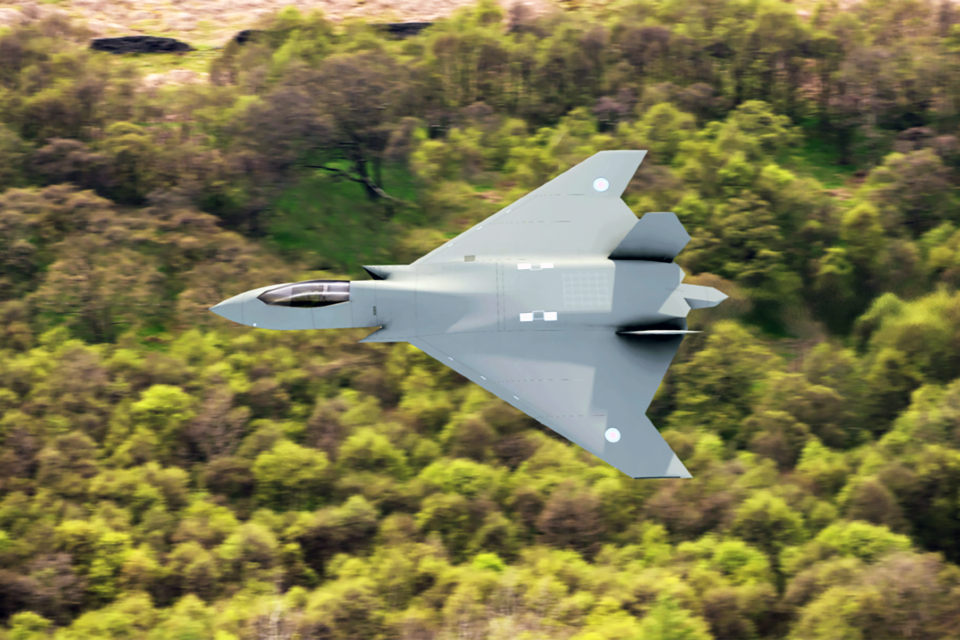
Air vehicle over a forest
Vision
UK Defence Air capability delivered at the time and place of its choosing, more efficiently, with fewer people, through the application of new and emerging technologies and evidence-based advice, provided by suitably qualified and experienced personnel.
Technical challenges
The programme aims to demonstrate and evaluate future military capability by integrating technologies and concepts from across the science portfolio, industry and civil funded research. It matures and integrates underpinning technologies to create capability solutions at the system and system of systems levels.
The programme will also:
- undertake operational analysis to support air and aviation capability planning and key acquisition project decisions
- identify, in partnership with UK armed forces, concepts and technologies from across science and technology (including industry and academia), for rapid development into capability solutions to meet major military challenges
- maximise the potential of the human component; this includes aspects such as recruitment, training and development, retention and resilience
Capabilities
Delivery of this programme requires:
- air system concept development and assessment
- air operational analysis and decision support
- development of key air system technologies, such as:
- propulsion,
- structures,
- aerodynamics,
- flight control,
- weapons integration,
- mission systems and autonomy,
- survivability and platform protection;
- this includes the assessment of different options, trade-offs and constraints including the identification, evaluation, and assimilation of new science and technology;
- supports new and existing requirements through the development of engineering concepts and assessment
- development, evaluation and assessment of air autonomous system and system-of-systems concepts and associated requirements
- air vehicle survivability analysis, modelling and simulation approaches against current and emerging hard and soft kill threats
- air signature management, technologies, concepts and control measures to mitigate radio frequency (RF), electro-optical/infra-red (EO/IR) and acoustic threats
Benefits to UK defence and security
The benefits of this programme will be:
- critical suitably qualified and experienced personnel (SQEP) maintained to support decision-making and assurance, ensuring access to expert advice on air-related risks and issues
- increased capability or reduced through-life and workforce costs through the use of advanced air environment technologies, within systems and ‘system of systems’ technologies
- critical international collaborations enhanced or maintained to ensure UK obtains maximum leverage and benefits from its international relationships
- integrated air and aviation concepts identified, understood, developed and de-risked to meet key challenges in the most efficient and cost-effective manner
- integrated air systems analysis, ensuring that robust evidence-based decisions can be made
- maximised efficiency and performance of the human components through improved training, development and personnel welfare
- advanced ability to gather, process and act upon the information available to deliver decisive operational advantage
- access to novel force protection solutions that deter, prevent, nullify and minimise the effectiveness of adversary attacks in the complex air ground environment
- protection of forces and infrastructure from advanced first- and second-generation uncrewed aerial systems (UAS) threats in a workforce-efficient and cost-effective manner.
Commercial routes
- Analysis for science and technology research in defence (ASTRID)
- Serapis
- DASA
- R-Cloud
- Aurora Engineering Partnership
- Team Tempest
Point of contact
Dstl Air Systems Programme Manager, Steve Simm
4. Autonomy
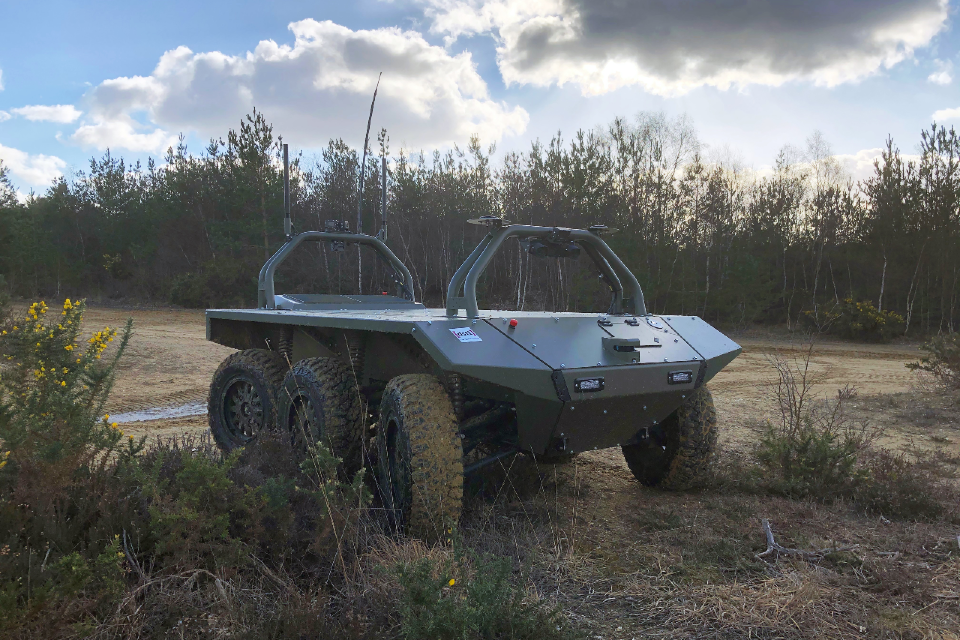
Autonomous land vehicle
Vision
Supporting the operationalisation of autonomy across defence now; while driving cutting-edge autonomy options for the future.
Technical challenges
The technical challenges of this programme are to:
- drive generation-after-next autonomous system concept demonstrators rapidly towards exploitation, including novel enabling technology research
- provide the means to safely and securely operationalise robotic and autonomous systems
- identify and address common barriers to operationalising autonomy, to maximise defence’s ability to plan for and deliver capability at scale and pace
- develop best practice to maximise effectiveness and minimise risk in human-autonomy teams
- leverage international, academic and private venture gearing, and exploit civil developments across the entire programme, to achieve advances in autonomy and overcome technology deltas to achieve defence and security benefit
Capabilities
Delivery of this programme requires capabilities in:
- robotics and autonomous systems (RAS)
Benefits to UK defence and security
The benefits of this programme are in:
- autonomy concepts:
- MOD has options to procure or further pursue autonomous concepts into experimentation, training and capability planning
- UK is at the forefront of enabling the generation-after-next of robotic and autonomous systems for the Defence challenges of the future
- accelerated development of emergent and maturing technologies
- human-autonomy teaming: defence understands and can make informed choices to optimise the effectiveness of human/intelligent system teams and fully unlock the potential of intelligent systems to deliver operational advantage
- overcoming barriers to autonomy: evidence to de-risk the maturation and adoption of the most challenging autonomy concepts
- safe secure assured autonomy:
- UK has the ability to provide hardened autonomous systems, resilient against adversarial attack and technological errors
- UK has the ability to provide sufficient verification and validation for certifying autonomous capabilities as trusted and assured for national and coalition operations of the future
5. Chemical Biological and Radiological (CBR) Defence
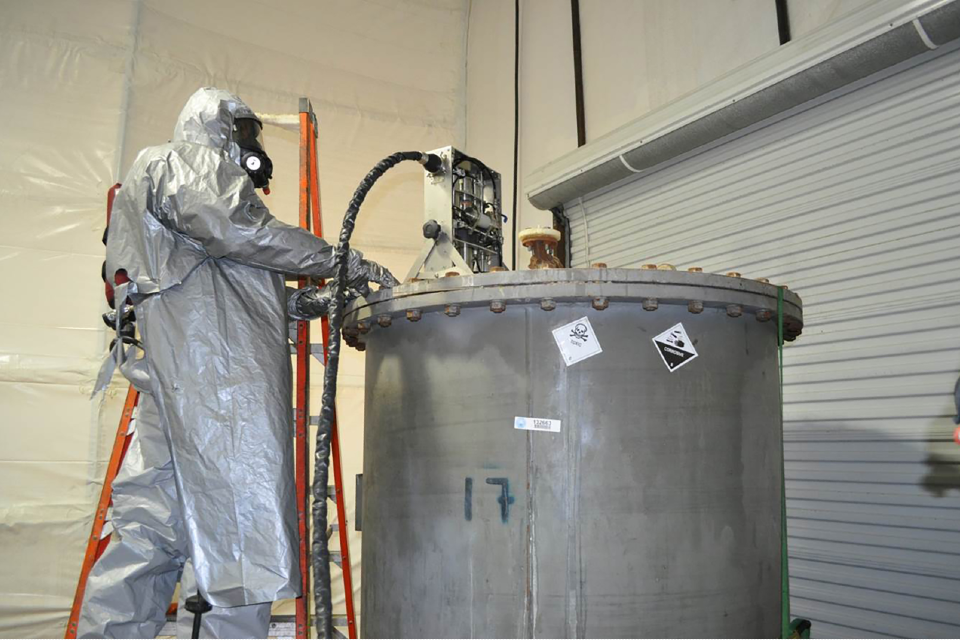
Person in hazmat suit
Vision
Outpacing chemical, biological, radiologicial and nuclear (CBRN) adversaries and threats through cutting-edge science to provide operational advantage for UK defence and security.
Technical challenges
The technical challenges of this programme are to:
- understand: a sovereign capability to assess, understand and anticipate risks for CBR defence, security and resilience
- prevent: actions to engage and constrain adversaries are driven by scientific evidence and analysis; effects are delivered with cutting edge capabilities
- protect and recover: capability development is underpinned by scientific evidence and analysis; cutting edge capabilities are assured and evaluated
Capabilities
Delivery of this programme requires:
- CBR diagnostics and medical countermeasures
- CBR sensing
- CBR situational awareness
- CBR counter-proliferation
- CB analysis and attribution
- CBR operational response
- radiation protection
- CBR hazard assessment
- CBR hazard management
- CBR physical protection
Benefits to UK defence and security
This programme will:
- deliver science and technology to achieve operational advantage
- achieve evidenced and effective decision making using science and technology
- achieve strategic influence and enhanced science and technology delivery through collaboration
Commercial routes
You can also engage with us via the UK Industry’s Chemical, Biological, Radiological and Nuclear Defence Special Interest Group (CBRN-UK)
Point of contact
6. Communications and Networks

Graphic of waveforms
Vision
Through science and technology, MOD has advanced options to enable resilience, reach and autonomous interoperability in its communications and networks in order to enable multi-domain integration and deliver against defence’s multi-domain C4 challenge.
Defence is already facing the challenges of increased demand for information, with more sensors collecting more data, and increased speed of data analysis and decision-making with machine learning and artificial intelligence applications. At the same time, there is an increasing demand for communication resources, due to the growth in novel battlefield assets, such as remote and autonomous systems. All these systems require access to the electromagnetic spectrum for communications, for information, and for command and control.
The Communications and Networks programme will be investing in potential solutions to these challenges, from the novel use of the electromagnetic spectrum, alternative communications mechanisms, adaptive and autonomous networks, and novel data routing algorithms, to improve the availability of secure information to military systems and decision-makers at the time and place of need.
The programme is looking to grow and access a diverse community of suppliers, including universities and academics, non-traditional defence suppliers, as well as the established defence primes, in order to stimulate innovation and to accelerate potential solutions through to concept demonstration.
Technical challenges
We anticipate an increasing requirement for military systems to communicate and to sense, while defending against electronic and cyber-attack, and for this to be done in close proximity, if not simultaneously, in time, in the electromagnetic spectrum and using the same sub-systems. We refer to this as C5I convergence (command and control, computing, communications, cyber and information).
To achieve this we will:
- develop and demonstrate concepts for C5I convergence and integration
- develop and prototype architectures for resilient networks and data services
- develop and prototype resilient communications bearers and waveforms
- develop and prototype technologies for future beyond-line-of-sight communications
Capabilities
The programme will invest to grow the communications and networks, and information systems capabilities, through enhanced collaboration and partnership with industry, with academia and with wider government.
Benefits to UK defence and security
Enhanced investment in the generation-after-next of communications and networks, and information systems will ensure:
- defence has the capabilities necessary to achieve the resilient communications at reach, which are critical for multi-domain integration
- defence has the necessary evidence to support investment in future communications and networks capabilities.
- UK defence achieves gearing and leverage from key allies and partner investments.
- defence will contribute to the national prosperity and levelling-up agendas through investment in significant partnerships with UK academia and industry
Commercial routes
- DASA
- R-Cloud
- Analysis for science and technology research in defence (ASTRID)
- Serapis: Lot 4 – Assured information infrastructure
Point of contact
7. Crime and Policing

Police cars with lights
Vision
The Crime and Policing programme provides UK policing, the criminal justice system, fire and rescue services, UK Border Force and the Home Office with science and technology expertise, applied advice and solutions that underpin crime, policing and security capabilities and counter criminal and terrorist activity in the UK.
Technical challenges
The technical challenges of this programme include:
- innovative solutions to tackle e-scooter and e-bike enabled crime that that don’t rely upon infrastructure investments or modifications, and that do not put the rider at risk of injury
- stand-off solutions that can distinguish the presence of knives amongst other commonly carried benign metal items by people (keys, phones, coins) in uncontrolled public spaces
Capabilities
Delivery of this programme requires capabilities in:
- artificial intelligence and data science
- human and social sciences
- science and technology futures and incubator
- sensing
- weapons
Benefits to UK defence and security
This programme will:
- deliver a step change in policing and security capability through exploitation of next generation technologies and concepts
- inform and shape development of the future workforce
- provide assured detection, surveillance and search capabilities across the full spectrum of operational, cluttered, contested and denied environments
- derive and develop methods, techniques and systems that support intelligence-led training, criminal investigations and evidence recovery for law enforcement and the identity and disruption of criminal networks
- protect the UK population, society and economy from the impact of crime and terrorist activity through development of targeted science and technology
- influence and shape policy direction and underpin policy decisions as a result of the application of science and technology
Commercial routes
- DASA
- R-Cloud
- Analysis for science and technology research in defence (ASTRID)
- Human social science research capability (HSSRC)
Point of contact
This programme is run on behalf of the Home Office
8. Cyber Security

Large ship
Vision
Through science and technology, MOD has options to ensure that the UK’s military capabilities can be effectively and consistently defended against adversary cyber activities and threat.
Technical challenges
The programme will move the focus beyond identification of vulnerabilities and protection and detection of cyber events, towards technology enabled automated response and recovery. This will include development of S&T approaches to both proactively and reactively defend current, next generation and generation-after-next military niche equipment from evolving adversarial cyber-enabled capability.
The technical challenges of this programme are in:
- autonomous resilient cyber defence
- military systems information assurance
- reducing the cyber attack surface
- adaptive cyber resilience
- cyber mission assurance
Capabilities
Delivery of this programme requires capabilities in:
- cyber security
- data science
- human science
- operational research
- systems thinking
- software engineering
- radio frequency engineering
- applied mathematics
Benefits to UK defence and security
This programme will deliver science and technology to achieve operational advantage, evidenced and effective decision making, strategic influence and enhanced science and technology through collaboration and by creating prosperity.
Commercial routes
- DASA
- R-Cloud
- Serapis
- Analysis for science and technology research in defence (ASTRID)
- Human social science research capability (HSSRC)
Point of contact
9. Defence Science and Technology Futures

Soldier using virtual screen
Vision
Defence is better prepared for the future through revitalised investment in science and technology futures activity to identify potential, incubate and rapidly test hypotheses and promote emerging insights of generation-after-next science and technology.
This will provide the stimulus for an agile science and technology portfolio and influence key defence decision making.
It will also create strategic advantage and address defence risk through the exploitation of an evidence-based understanding of the potential impact of emerging insights from the global science and technology.
Technical challenges:
The future of robotics
Current low Technology Readiness Level (TRL) developments in robotics indicate that rapid developments in specific technology areas are likely to have significant implications for the future of defence and security over the coming decades, through for example offering completely new ways of operating.
Are you working in this field and have any novel innovative ideas how defence could employ robotics for operational advantage? If so we would like to hear from you.
Room temperature superconductors
We are interested in the emergence of room temperature superconductors, which could lead to improvements in energy efficiency, and the reduction in energy requirements, mass, volume, or waste thermal output of components and systems that would utilise them.
Are you working on science and engineering of room temperature superconductors that will unlock their exploitation in prototype or early products within the next ten years or so? If you have novel innovative ideas for how we could work together to accelerate their maturity and want to get involved we would like to hear from you.
Acoustic protection
Vibration and sound can cause potential issues in the reliability of magnetic legacy hard disk drives (HDD).
Are you working on ways of mitigating such issues? Could you help us to develop mechanisms that would improve the resilience of our systems? If you think you can then we would love to hear about your ideas and work with you to mature them.
Granular fluid based suspension
Many of our vehicles operate in challenging terrains and it is considered that the incorporation of granular fluids into damping and suspension mechanisms could lead to improved ride comfort and reduced noise levels for our servicemen and women.
If you are working in this area of have novel innovative ideas that could help us to develop such mechanisms then we would like to hear from you.
High efficiency electrolysis
Would it be possible to develop a compact high efficiency electrolysis system capable of powering future military platforms or operating bases, replacing current fossil fuel based propulsion or energy generation systems and helping us to meet our targets for reducing our carbon footprint?
If you are interested in this technology and have novel innovative ideas how we could work together to mature a compact system then we would like to hear from you.
Capabilities:
Delivery of this programme requires capabilities in:
- science and technology futures and incubator
Benefits to UK defence and security
This programme will:
- deliver science and technology in order to achieve operational advantage
- achieve evidenced and effective decision-making using science and technology
- deliver the Government’s agenda and create prosperity through science and technology delivery
Commercial routes
Point of contact
10. Deterrent and Submarine Systems
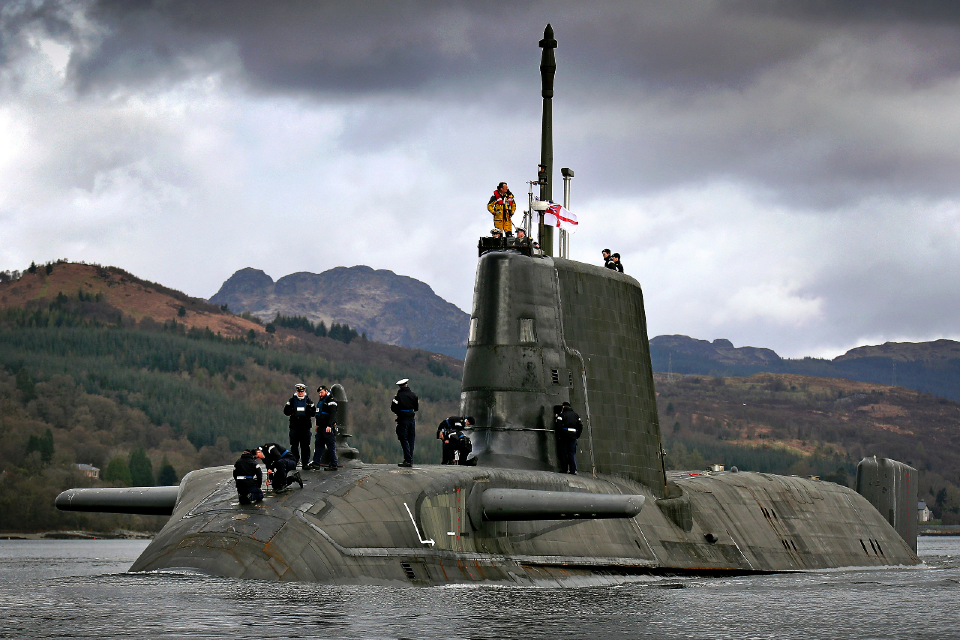
People standing on a submarine
Vision
Provide ground breaking science and technology, delivering technologies and other enablers that support the UK nuclear enterprise in providing:
- UK submarines with battle-winning superiority over potential adversaries
- the continued through-life credibility and effectiveness of the UK nuclear deterrent
Technical challenges
The technical challenges of this programme are in:
- modelling and simulation
- sensing
- communication
- stealth and survivability
Capabilities
Delivery of this programme requires capabilities in:
- strategic systems
- ballistic missile defence
- underwater capability
Benefits to UK defence and security
The benefits of this programme are:
- science and technology to de-risk future military capability that will give a competitive edge
- interoperability with allies
- assured access to sovereign capability to support continuous at sea deterrence
- access to robust evidence to support decision making
- enhanced UK prosperity and intellectual capital through close working with industry and academia
Commercial routes
- R-Cloud
- Progeny Maritime Research Framework
- Analysis for science and technology research in defence (ASTRID)
Point of contact
11. Electromagnetic (EM) Activities
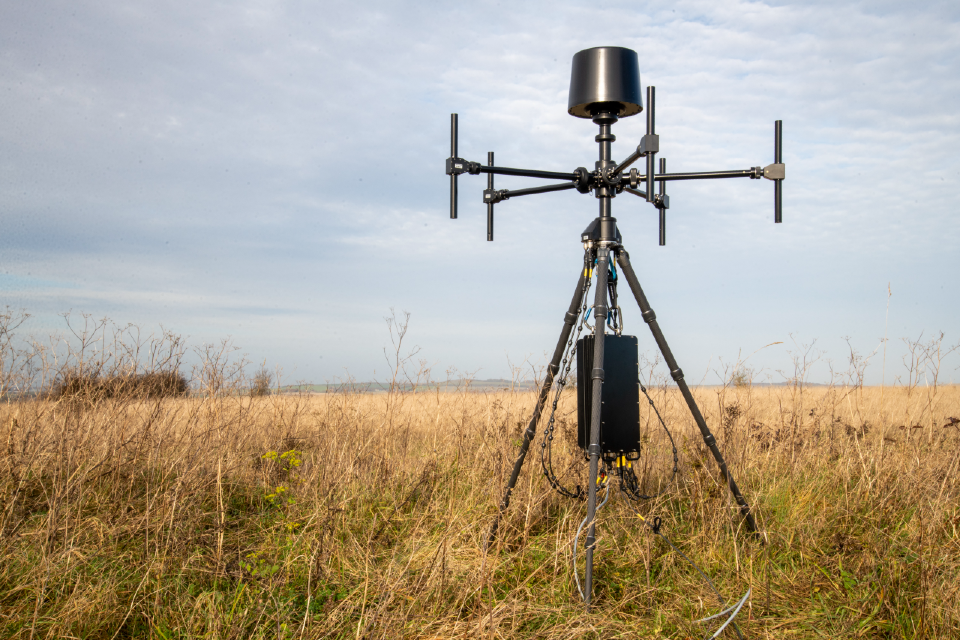
Scientific equipment in a field
Vision
Research has developed capabilities and services to allow synchronisation and coordination of electromagnetic activities, including enhanced electronic attack, to enable multi-domain operations and effects in the future electromagnetic environment (EME).
Technical challenges
Integrated electromagnetic activities
The enterprise system and architectures able to fuse and analyse data from radio frequency (RF) systems across an area of operation and enable the remote delivery of targeted EM effects. Delivering a step change in capability compared to current standalone systems and integrating the EM domain alongside air, land, maritime and space as an integral part of future multi-domain operations.
Innovative electronic attack concepts
Seeking to identify and exploit vulnerabilities in EM systems and standards to disrupt and degrade adversary capabilities.
Battlespace deception concepts
Degrading our adversaries’ situational awareness and protecting our forces from being targeted via the EME.
Electronic defence concepts
Providing protection to UK platforms and systems from threats while providing increased resilience against the pace of evolving threat technologies.
Electronic surveillance concepts
Providing tactical situational awareness and characterising adversary EM activities to enable precision electronic attack.
EM test and evaluation
Enabling rapid prototyping and assessment of EM concepts and technologies through the use of real and synthetic environments alongside modelling and simulation.
Capabilities
Delivery of this programme requires capabilities in:
- electromagnetic activities
Benefits to UK defence and security
Defence is critically dependent on the EME as a means to locate adversary activities, communicate and deliver effects (both offensive and defensive). Furthermore, multi-domain operations and effects are not possible without operational independence in, and control over access to, the EM environment.
The benefit of this research is to deliver the UK a step-change in:
- EME situational awareness capability
- capability to deter, deny, disrupt, degrade/destroy adversaries
- enhanced protection of our own forces
- enable the conduct of multi-domain operations
Commercial routes:
Point of contact
Phil Sparrow, Dstl EMA Programme Manager
12. Future Kinetic Effects and Weapons (FKEW)
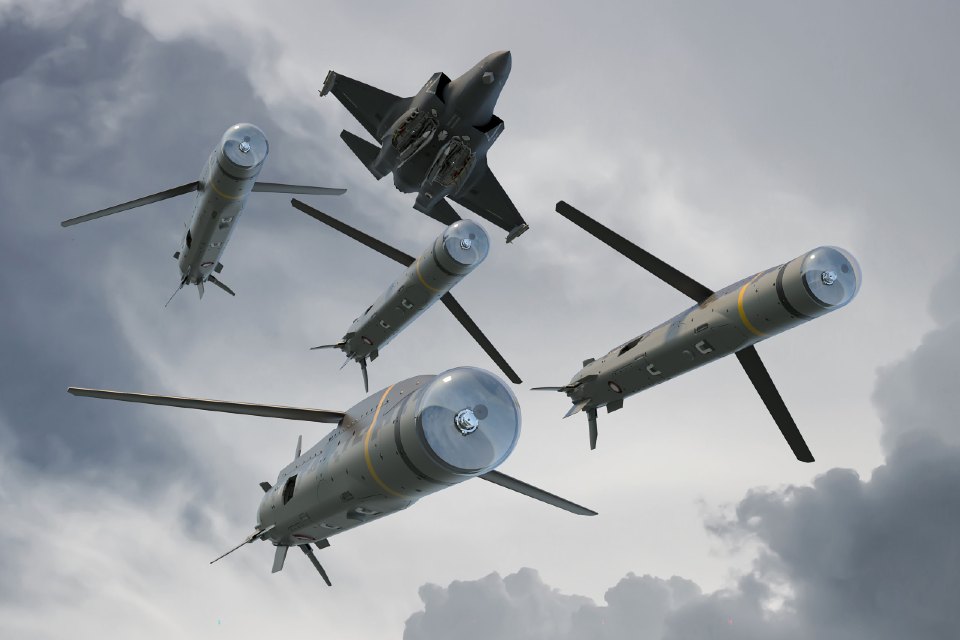
Graphic of missiles
Vision
Cutting-edge science and technology and robust evidence for effective decision-making for next-generation and generation-after-next weapons to provide hard power operational advantage while ensuring sustainment of critical UK suitably qualified and experienced personnel (SQEP), facilities and tools.
Technical challenges
We bring together game-changing technologies developed by scientists and engineers in industry and academia, alongside our own expertise, to find ways to revolutionise the future battlefield and support modernisation initiatives. Our aims are to:
- drive highly innovative weapons technologies and concepts across the UK armed forces
- provide advice and analysis to support MOD evidence-based decisions
- coherently manage MOD’s weapons science and technology SQEP and knowledge
Capabilities
Our weapons systems capability brings together a broad range of scientific and technical disciplines to support the full lifecycle of development, from refining requirements to bringing new concepts into service, covering:
- advanced missiles and collateral effects
- directed energy weapons and effects
- tactical effects including non-lethal weapons.
Benefits to UK defence and security
The programme supports the following strategic benefits:
- deliver science and technology in order to achieve operational advantage
- achieve evidence and effective decision making using science and technology
- deliver the Government’s agenda and create prosperity through science and technology delivery
Commercial routes
- DASA
- R-Cloud
- Weapons sector research framework (WSRF)
- Complex Weapons Innovation & Technology Partnership (CW ITP)
Point of contact
Simon Zavad, Programme Manager
13. Future Sensing
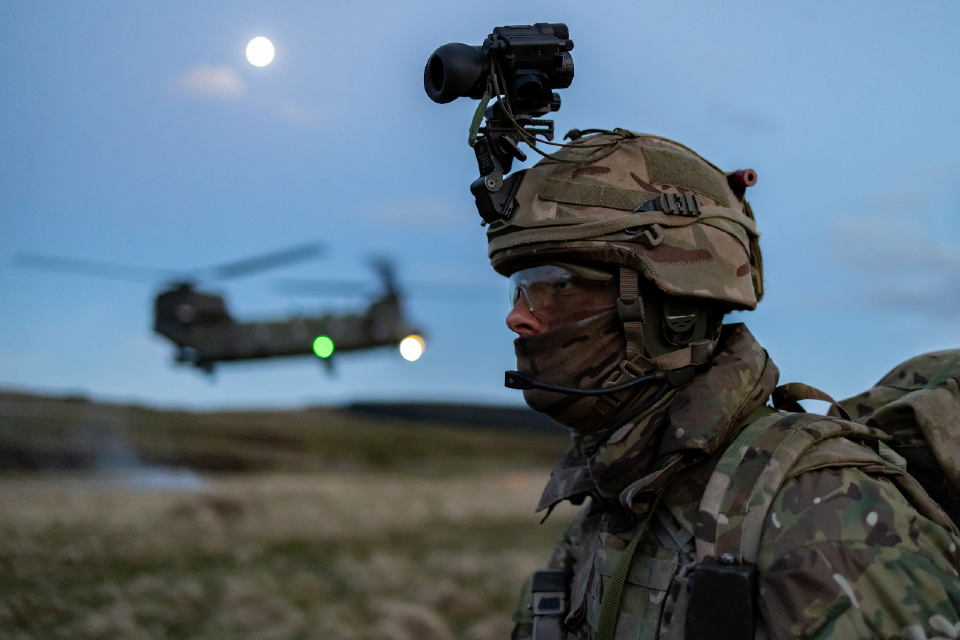
Soldier with camera on helment
Vision
Revolutionary novel sensing concepts and underpinning technologies to deliver pervasive, resilient situational awareness and targeting in future difficult congested and contested environments to enable operational advantage and freedom of action against complex and diverse threats.
Technical challenges:
The technical challenges of this programme are in:
- generation-after-next photonic and electronic sensing
- distributed coherent multi-modal multi-domain sensing
- sensor fusion and signal processing
- quantum sensing
- assured position, navigation and timing (PNT)
- resilient sensing in contested and congested environments
Capabilities
Delivery of this programme requires capabilities in:
- sensors and photonics
- electronics
- signal processing
- data and information fusion
- materials science
- computer modelling and simulation
- mathematics and quantum mechanics
Benefits to UK defence and security
The benefits of this programme will be:
- new generation-after-next future sensing concepts
- robust and resilient alternative concepts and technologies to global navigation satellite system (GNSS)-based position, navigation and timing solutions to underpin novel future sensing and EA concepts
- pervasive and resilient sensing in future harsh, challenging environments to deliver effects and support defence and security missions
Commercial routes
Point of contact
Dr John Robertson, Programme Manager
14. Future Workforce and Training

Person with virtual reality headset
Vision
Enhancing the defence workforce, now and for the future.
Identifying, developing and testing concepts and interventions to help defence achieve superiority through its people capability.
Technical challenges
Training and education
Improving learning effectiveness and efficiency, driving strategic change in learning, and developing future generations of learning systems representing the future operating environment.
Future workforce
Understanding and addressing risks to securing and sustaining the people component of capability, demonstrating duty of care, and providing inclusive environments.
Humans in systems
Generation-after-next human-machine interfaces, and integration of the human and technological elements of future systems.
People demand signals
Understanding the demand signals for future People capability in terms of knowledge, skills, experience and other characteristics and how these differ from today.
Radical approaches for defence people
Identifying game changing people concepts, people-focused horizon scanning and technology watch.
Capabilities
Delivery of this programme requires capabilities in:
- human and social sciences
- training and simulation
- data analytics
Benefits to UK defence and security
The benefits of this programme are:
- development of a robust science and technology evidence base to develop new strategies for workforce and training – the work benefits science and technology by growing and maintaining skills especially in taking research through to demonstration and building, gaining access to skills and experimentation
- defence will maximise the investment and knowledge through more efficient training solutions enabling more effective and resilient options and wider benefits.
- stakeholders can maximise the efficiency and performance of the human components through improved personnel policy/strategy
- increased efficiency of training and development through new and emerging technology to support next generation and generation after next training, learning systems and workforce welfare
Commercial routes
- DASA
- R-Cloud
- Serapis Lot 5: Simulation and synthetic environments
- Human social science research capability (HSSRC)
- Analysis for science and technology research in defence (ASTRID)
Point of contact
15. High Level Decision Support

Hands moving tokens on a map
Vision
Equipping defence with evidence and analytical tools to prepare it for the future with high-level policy, investment of resources and support to make strategic operational decisions.
Technical challenges
The technical challenges of this programme are in:
- innovative thinking about the future defence and security environment, and the challenges and opportunities that may arise
- access to rapid, resilient, robust and maintainable models, tools, techniques and data which can help improve decisions at a whole-force level
- applying wargaming to new and evolving problem areas, but especially joint and multi-domain operations and non-physical issues)
- identifying, developing and exploiting new approaches, including commercial-off-the-shelf approaches
- advancing the state of the art in analytical wargaming, but especially strategic analytical wargaming
Capabilities
Delivery of this programme requires capabilities in:
- operational research (this is our main capability)
- AI and data science
- human and social sciences
- science and technology futures and incubator
Benefits to UK defence and security
The benefits of this programme will be:
- improved defence decision- and strategy-making
- clear direction and recommendations to defence on how emerging strategic issues and risks should be addressed
- sustain and improve models and tools for high level decision-making for the department
Commercial routes
Point of contact
16. Human Performance and Protection

Laboratory
Vision
Science and technology to protect and optimise performance of UK forces to increase survivability and reduce vulnerability.
Technical challenges
The technical challenges of this programme are in:
- optimising human performance
- screening and diagnosis of illness and injury
- treatment of injury
- prevention of illness and injury
Capabilities
Delivery of this programme requires capabilities in:
- human performance and protection
- medical sciences
Benefits to UK defence and security
The Human Performance and Protection programme will:
- deliver science and technology in order to achieve operational advantage
- achieve evidenced and effective decision-making using science and technology
- achieve strategic influence and enhanced science and technology delivery through collaboration
17. Hypersonics
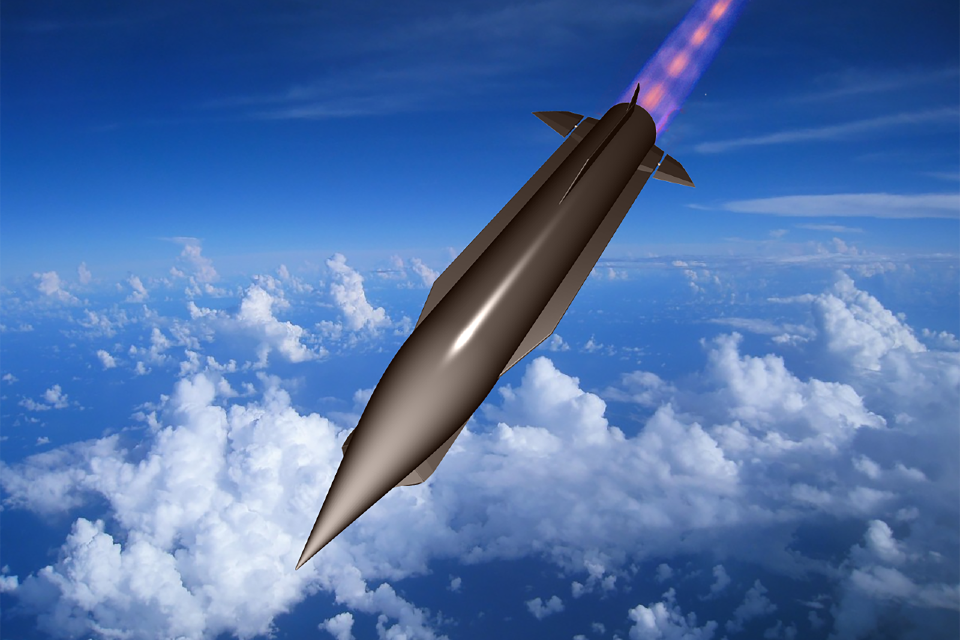
Graphic of a missile
Vision
To demonstrate a high speed weapon (HSW) airframe with supporting sub-systems and develop future hypersonic concepts and technologies to provide transformational and affordable options to deliver operational advantage for the future UK armed forces.
Technical challenges
The technical challenges of this programme are to:
- deliver the demonstration of a UK high speed weapon technology base
- develop hypersonic weapons concepts and technology
- support a UK hypersonic enterprise
Capabilities
Delivery of this programme requires capabilities in:
- weapons systems
- advanced materials
Benefits to UK defence and security
The benefits of this programme are that:
- the UK will develop a portfolio of hypersonic science and technology to support development of generation-after-next capability
- the UK will be a credible partner for hypersonics science and technology
Commercial routes
Points of contact
Richard Crabtree rcrabtree@dstl.gov.uk
Rosie Davis rdavis2@dstl.gov.uk
18. Influence and Command

Graphic of a person with information coming out of their head
Vision
Through science and technology, defence can harness the behavioural and analytical science and the socio-technical capabilities to provide improved methods, tools, and techniques, to develop influence, command and control - integrating these elements to create advantage for defence and wider government.
Technical challenges
The technical challenges of this programme are to develop:
- human and social science tools and techniques to better understand audiences
- socio-technical methods to influence behaviour, deter adversaries, and allow defence to persistently engage
- underpinning command and control doctrine, concepts, methods, models and tools, to support defence’s approach to revise and update its philosophy of command and control
Capabilities
Delivery of this programme requires capabilities in:
- human and social sciences
- operational research
- information systems
- AI and data science
- science and technology futures and incubator
Benefits to UK defence and security
The benefits of this programme are that:
- defence and wider government will be better able to understand the evolving information environment to advise and improve on future decision making to command and influence
- defence and wider government will have access to improved methods, models, tools and approaches developed through science and technology to influence our potential adversaries, command ourselves and deploy across all domains, through the information environment
- defence will be able to experiment and exploit future opportunities in order to develop new capabilities for influence and command, and evidence for force development decisions
Commercial routes
Point of contact
19. Land Systems
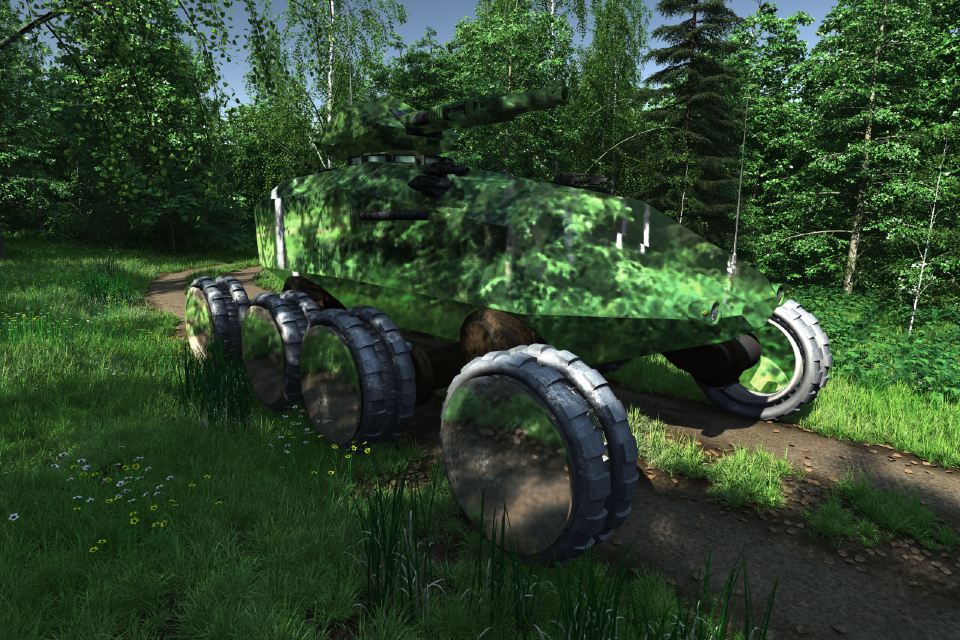
Camouflaged land vehicle
Vision
From concept to capability: enabling the British Army to achieve technological and operational advantage.
Technical challenges
The technical challenges of this programme are in:
- future concept development and assessment, ensuring that threat-driven live, virtual and constructive (LVC) experimentation is at the heart of technology development
- Systems Integration
- crewed and uncrewed systems: human-machine teaming
- sensor to effector technologies
- enhanced situational awareness and information exploitation
- increased lethality and survivability
Capabilities
The programme involves a wide mix of capabilities relating to the Land domain. This includes analytical, engineering and scientific skillsets spanning expertise across the Land Environment:
- electronic architectures
- human factors
- mobility
- lethality
- survivability
- operations research (OR)
- systems integration (systronics)
The Land Systems Programme will exploit capabilities from across Dstl, industry, academia and international relationships to:
- understand technology opportunities: through our outreach and understanding of global developments in technology. This drives the development of drives the development of technical, system and capability concepts
- develop and test concepts: in order to understand their military utility and effectiveness. The, to be developed, Land Experimentation Lab will be a key enabler for this. This will identify specific technology requirements
- develop technology: mature the most promising technologies to an appropriate technical readiness level (TRL) (at least TRL 6)
- understand the systems integration challenges: exploitation and integration challenges are identified, and resolved, much earlier in the technology maturation life-cycle
- conduct concept refinement and testing: the concepts are refined, based on our greater understanding of the technology, and re-tested to ensure they still offer military utility
- build the evidence base: the output is the evidence (technology driven, risk aware, concept) to support the Army in its modernisation programme to improve how it operates in the future against a range of threats.
Benefits to UK defence and security
The benefits of this programme are that:
- the Army will be enabled to field military capability that will give it an increased competitive edge against all potential adversaries
- through close and collaborative working, the Army will be more interoperable with its closest allies
- defence will have assured access to the UK sovereign science and technology capability in armour
- the Army will have access to robust evidence in order to inform future warfare and tactical development, force development and military capability investment decisions
- industry and academia will benefit from a closer working relationship with the Army and more broadly the science and technology enterprise, through the development of the Land Experimentation Lab
Commercial routes
- R-Cloud
- Analysis for science and technology research in defence (ASTRID)
- Serapis
- Weapons sector research framework (WSRF)
Point of contact
Richard Hooper, Land Systems Programme Manager
20. Maritime Systems
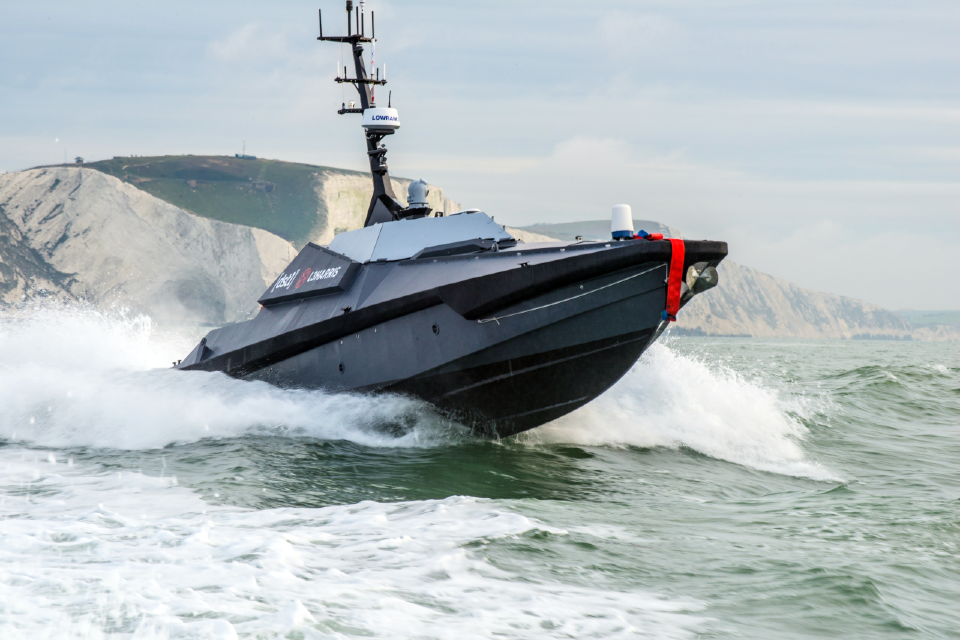
Autonomous boat at sea
Vision
From concept to capability: delivering the science and technology that enables the Royal Navy to achieve technological and operational advantage.
Technical challenges
The technical challenges of this programme are in:
- future concept development and assessment
- systems integration for crewed and uncrewed systems
- modelling and simulation
- sense, decide and effect
- maritime lethality and survivability
Capabilities
The programme involves a wide mix of capabilities relating to the maritime domain. This includes analytical engineering and scientific skillsets spanning expertise across above and underwater capabilities.
Benefits to UK defence and security
The benefits of this programme are:
- science and technology has de-risked future military capability that will give the Royal Navy a competitive edge
- interoperability and Interchangeability with allies
- assured access to sovereign capability to support Royal Navy operations, including continuous at sea deterrence
- access to robust evidence to support decision making for Royal Navy operations and procurements
- enhanced UK prosperity and intellectual capital through close working with Industry and academia, supporting Global Britain
Commercial routes
- Progeny Maritime Research Framework
- Analysis for science and technology research in defence (ASTRID)
- R-Cloud
- G-Cloud
Point of contact
21. Missile Defence

Missile launches from ship
Vision
The Missile Defence Science and Technology Programme supports the 2020 MOD Science and Technology Strategy intent by ensuring that the Missile Defence Centre (MDC) is able to operate as the UK’s centre of excellence for missile defence and maximise the opportunities presented through collaboration with international partners and working closely with UK industry and academia. Specifically, the programme will fund research to underpin the development of generation-after-next capabilities and sustain critical capabilities on behalf of UK defence and security.
Technical challenges
The technical challenges of this programme are:
- evolution of missile threats to include hypersonic glide vehicles and hypersonic cruise missiles
- maintenance of limited and fragile suitably qualified and experienced personnel (SQEP) to support government decision-making on missile defence
- transition from science and technology into capability
Capabilities
Delivery of this programme requires capabilities in:
- strategic systems
- survivability
- weapons
- sensing
Benefits to UK defence and security
The benefits of this programme are that decision makers:
- will better understand current and emerging missile threats
- will have improved access to technologies, methodologies and concepts that reflect current and future needs
- will have access to technologies, methodologies and concepts that can contribute to operational advantage
- are able to access independent, impartial, expert advice to make informed decisions about current and future capability requirements
- will have access to technologies, methodologies and concepts – developed and or demonstrated through science and technology – to support capability and operational advantage
- will be enabled to evidence and support investment options surrounding countering ballistic and advanced missile threats through trials and demonstrations
- will benefit from access to SQEP, facilities, and capabilities of international partners
- will benefit from access to SQEP, facilities, and capabilities in UK industry and academia that can support missile defence
Commercial routes
- Analysis for science and technology research in defence (ASTRID)
- Test, Trials, Training and Evaluations
Point of contact
22. Security Systems
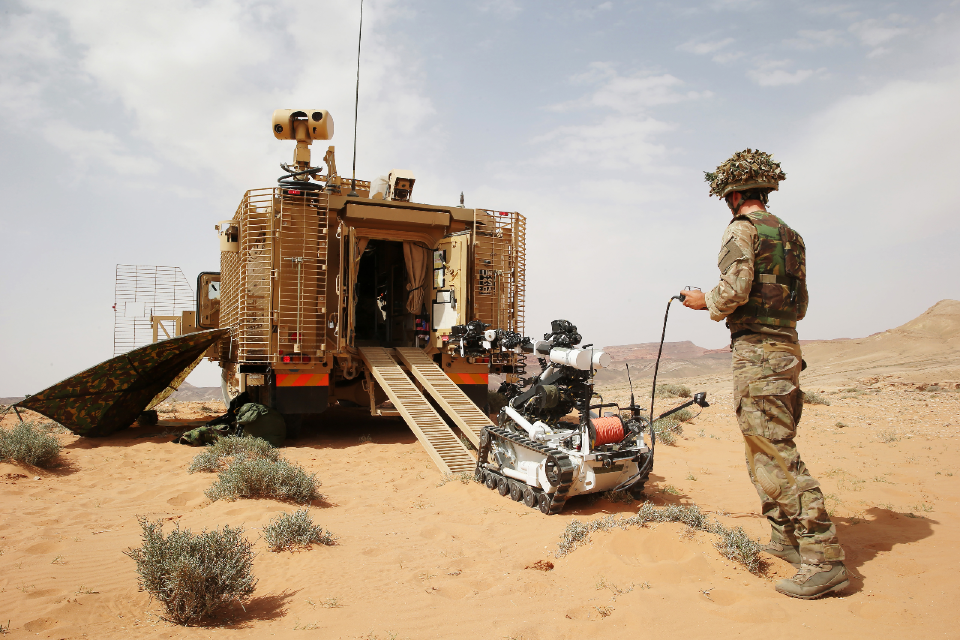
Soldier and robot in the desert
Vision
Provide an integrated, effective and responsive UK Government science and technology capability for countering explosive threats, devices and associated systems; delivering operational advantage, and minimising the risk to life on defence and counter-terrorism operations in the UK and abroad.
Technical challenges
The technical challenges of this programme are:
- locate, detect and identify illicit substances (such as explosives and narcotics)
- locate, detect and render safe improvised explosive devices (IEDs)
- development of electronic countermeasures
- modelling and simulation of explosive effects
- application of forensic science for specialised and challenging scenarios
Capabilities
Delivery of this programme requires capabilities in:
- homeland security and counter-terrorism systems
- explosives and energetics
Benefits to UK defence and security
The benefits of this programme are:
- continued development and provision of capabilities for exploitation and for forensic explosives analysis
- increasing understanding of improvised threats and how best to counter them
- development of robust location, detection, diagnostic, identification and disposal systems for current and emerging explosive threats and components (including through the use of search dogs)
- improved contractual arrangements with industry to enable science and technology delivery
- high and increasing value for money for the UK through International collaboration
- development of growing intellectual property portfolio for commercialisation with industry
Commercial routes
- DASA
- R-Cloud
- Analysis for science and technology research in defence (ASTRID)
- Serapis
- Human social science research capability (HSSRC)
Point of contact
23. Space Systems

Image copyright Airbus
Vision
Through science and technology, MOD has investment options to build strength in Space, and has matured its approach to Space as an operating domain to meet the ambitions of the Defence and National Space Strategies.
Technical challenges
The technical challenges of this programme include:
- space based payloads and concept demonstrators across all aspects of defence use of Space
- tools, techniques and architectures for space situational awareness
- novel technologies for satellite communications
- evaluation of threats in Space (both natural and manmade) to military capability and the development of mitigations and resilience measures
- novel technologies for Space-based intelligence, surveillance and reconnaissance (ISR)
- launch to orbit trajectory modelling capability to enable UK-based access to space
Capabilities
Delivery of this programme requires capabilities in:
- Space Systems
Benefits to UK defence and security
The benefits of this programme are that:
- defence has evidence for next-generation space capability to inform policy and operational capability choices through science and technology contribution to Defence Space Portfolio (DSP) technical demonstrators
- defence will have options for generation-after-next space capability by accessing science and technology developed under this programme
- defence will be enabled to make evidenced-based decisions for future space capability at Strategic Defence and Security Review (SDSR) 2025, through development of concepts and technology options by this Space Systems programme
- defence has a mature and stable science and technology pipeline for Space as a part of the broader research and development ecosystem
- Space science and technology capability has been stimulated, grown and maintained both internally and externally; the work benefits science and technology by growing/ maintaining skills, specifically in taking research through to demonstration and building or gaining access to skills and experimentation capabilities in Space Systems
24. Specialist Systems
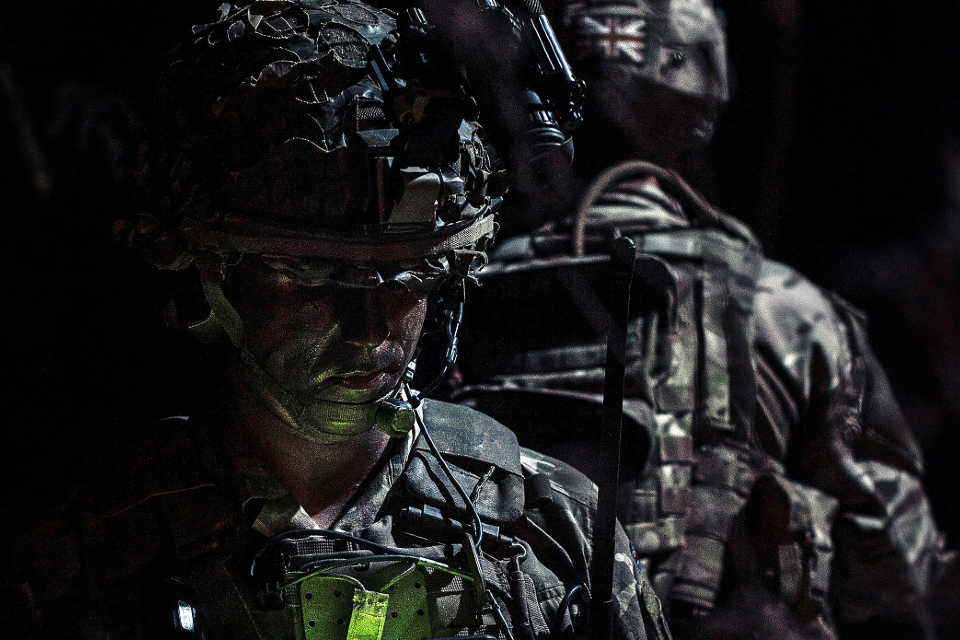
Soldier with special equipment
Vision
Drive and develop world leading science and technology that promotes options to support strategic operational advantage for the Specialist Users (SU) in delivering unique, timely global effects with high precision and minimum signature. Achieve this through the analysis, acceleration and demonstration of generation after next novel concepts and technology, guiding and combining all-source science and technology into systems solutions.
Technical challenges
The technical challenges of this programme are:
- force projection - freedom of access and manoeuvre
- sensing and understanding of the operational environment
- interoperability including secure networks and communications
- data exploitation
- provision of tactical effects that over-match our adversaries
- capabilities that both de-risk and enable special operations
- signature management
Capabilities
Delivery of this programme requires capabilities in:
- above water systems
- communications and networks
- homeland security and counter-terrorism systems
- operational research
- robotics and autonomous systems
- sensing
- survivability
- underwater systems
- weapons
Benefits to UK defence and security
This programme will:
- deliver science and technology in order to achieve operational advantage
- achieve evidenced and effective decision-making using science and technology
- achieve strategic influence and enhanced science and technology delivery through collaboration
- deliver UK Government agenda and create prosperity through science and technology delivery
Commercial routes
- DASA
- R-Cloud
- Analysis for science and technology research in defence (ASTRID)
- Progeny Maritime Research Framework
- Serapis
- Test, Trials, Training and Evaluations
Point of contact
25. Support and Sustainability

Soldier using solar panel
Vision
Establishing a suite of scientific and technical demonstrators and research projects to enhance defence understanding of potential solutions to support and sustainability problems.
Technical challenges
Defence, climate and sustainability
The MOD Climate Change and Sustainability (CC&S) Strategic Approach sets out the ambition, principles and methods needed for UK defence to meet the challenges of climate change.
If you are working on solutions that will help address the most pressing current sustainability issues and emission targets we want to hear from you to help develop an understanding of the potential options for research studies and demonstrators to enable defence to assure and sustain capabilities given climate change and meet national and departmental aspirations, including Net Zero 2050.
Defence logistics and support
Logistics and support is a critical task for MOD and represents a significant proportion of defence expenditure. We want to work with you to identify future technologies and processes that can deliver a step change for defence support, and subsequently future MOD, including baselining future energy requirements, future energy technologies, utilising data science, autonomy and automation, modern maintenance regimes, additive manufacturing techniques and influencing culture and behaviours.
Power and energy
Are you working on power, energy storage, conversion and transmission? This is one of the 7 technology families set out in the Defence Technology Framework. As such it is judged to be one of the foundational areas of technology that UK defence believes will be critical to drive innovation and radical transformation across a range of MOD activities, from optimising the performance of military equipment, to reducing its cost, to enabling new or enhanced military effects. It is also key to supporting the intent of defence to reduce environmental impact.
Effective Test and Evaluation
MOD needs to be able to rapidly test and evaluate (T&E) systems developed from the science and technology community, in order to be able to safely deploy technology with the confidence that it will perform to a known level.
MOD needs to be able to rapidly take advantage of science and technology innovation and we want to work with you to co-create a T&E Enterprise that is dynamic, agile and primed to deliver UK defence’s future technological, safety and operational challenges in order to maintain operational advantage.
Capabilities
Delivery of this programme requires capabilities in:
- operational research
Benefits to UK defence and security
This programme will:
- deliver science and technology in order to achieve operational advantage
- achieve evidenced and effective decision-making using science and technology
- achieve strategic influence and enhanced science and technology delivery through collaboration
- deliver the UK Government’s agenda and create prosperity through science and technology delivery
Commercial routes
Point of contact
Projects:
The following sections cover 4 standalone projects of the Defence Science and Technology Portfolio that have significant funding and collaborative opportunities for industry and academia.
1. Engineering Biology

Graphic of DNA
Vision
Synthetic biology can be defined as the design and fabrication of biological components and systems that do not already exist in the natural world, for useful purposes. Engineering biology is the process of identifying synthetic biology solutions and translating them into products, or in MOD’s terms, capability.
Engineering biology is a disruptive technology. Synthetic biology and engineering biology can provide new capability for UK defence and security, solving historically intractable defence problems.
Technical challenges
The top 3 challenge areas identified as potentially benefitting for engineering biology approaches have been identified as:
Materials
Current processes to make existing military grade materials suffer from various drawbacks: availability of raw materials, unsustainable costs, high energy consumption, handling of toxic waste, and possibly compromising on some desirable properties to meet performance requirements. For many of these problems, traditional materials approaches have made progress but are facing diminishing returns on their efforts.
The UK Government has also made commitments to zero carbon targets in the future, which means pursuing less energy-intense approaches.
Consequently, availability of many military relevant materials becomes limited and poses potential supply-chain risks for these countries.
There is also a pressing need for novel materials to provide new or enhanced capabilities, such as functional materials, where existing traditional materials science approaches have failed to make much progress.
Power and energy
Engineering biology concepts could provide a step change in power and energy provision, addressing several challenges currently faced in the area.
High energy batteries can be flammable and explosive when abused. Approaches that can mitigate this either at the chemistry level by using novel cell materials or using engineered biology materials to prevent fire and thermal runaway as an appliqué to standard commercial off-the-shelf cells would be of interest.
Despite significant research and advances in batteries (and other power sources) new military capability still require higher energy rechargeable batteries in smaller weights and volumes. Next-generation rechargeable batteries promise over 400 watt-hour per kilogram and 800 watt-hours per litre but there is interest in any technology that can improve these metrics even further. Primary (non-rechargeable) batteries are used less often, but are still used where their even higher specific energy and energy density warrants it. Engineered biology approaches to produce very high specific energy (>500 watt-hour per kilogram) and (1000 watt-hours per litre) single use batteries would also be of interest.
Sensing
Sensing is a fundamental enabler of defence and security activities. However, there is always a requirement for more sensitive sensors to a wider range of stimuli. Robustness is also necessary to avoid, for example, dazzling of sensitive sensors.
Capabilities
Delivery of this programme requires capabilities in:
- chemical, biological, and radiological
- human and social sciences
- explosives and energetics
- sensing
- science and technology futures and incubator
- advanced materials
- above water systems
- under water systems
- air systems
- land systems
- homeland security and counter-terrorism systems
- weapons
Benefit to UK defence and security
Materials
- new energetics
- lightweight armour
- DNA data storage
- self-healing polymers
- reactive camouflage
Power
- diversified fuel sources
- place and forget power sources
- ultra high efficiency solar
- new battery paradigms
Sensing
- olfactory mimicry
- bioassembled sensing structures
- autonmous microbial reconnaissance
- bioquantum sensing
2. Human Augmentation
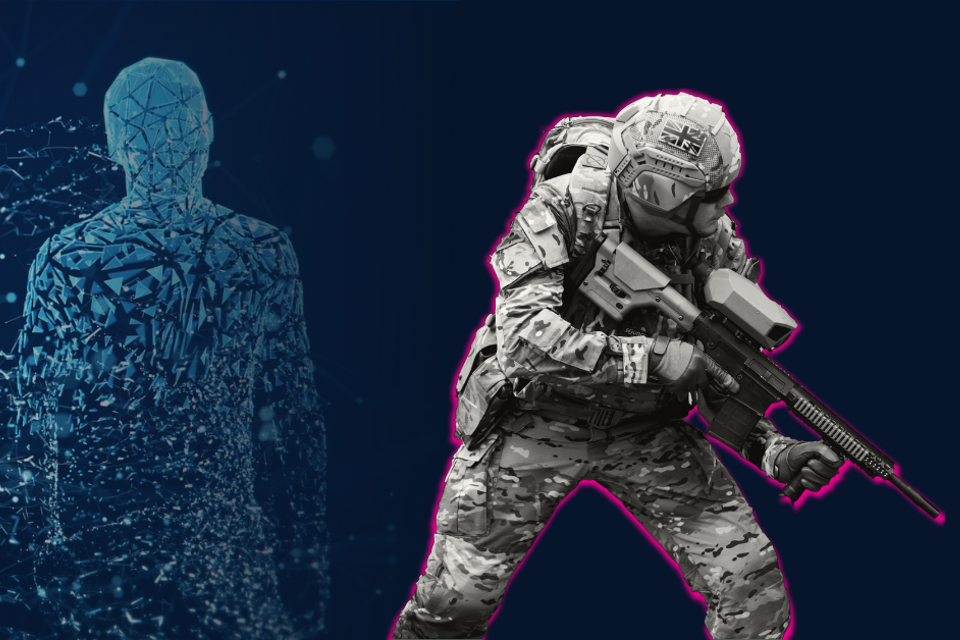
Virtual person next to soldier
Vision
To provide a single, coherent and targeted focus for science and technology to inform the defence vision, achieve desired outcomes and lead the strategic ambition for human augmentation (HA).
Technical challenges
The Human Augmentation project is collaborating with academia and industry to facilitate the generation of innovative approaches that will answer the question: ‘Where could human augmentation technologies be applied to achieve competitive advantage for UK defence and security?’
The project is interested in generation-after-next technologies that deliver a competitive advantage to UK defence and security by:
- optimising physical and/or psychological performance
- enhancing physical and/or psychological performance
- enabling an individual to work sustainably and for longer at a desired level (at or above the normal baseline) of performance
- countering, or overcoming, those factors that challenge performance and delivering ways to effectively restore previously achieved performance
Examples of candidate human augmentation technologies include (but are not limited to):
- wearable assistive devices (such as exoskeletons, devices to enhance senses)
- sensory enhancement technologies
- nutritional supplements
- pharmacological interventions
- manipulation of the microbiomes
- neurotechnologies
- novel materials
- implantable devices
- synthetic biology
- cross reality (for example virtual reality, mixed reality, augmented reality)
- robotics
Further examples can be obtained from the Defence Technology Framework 2019, and the Development, Concepts and Doctrine Centre (DCDC) strategic implementation paper 2021.
In addition to exploring novel technologies (as well as considering novel ways to use combinations of existing technologies), the project is developing tools to support the potential implementation of human augmentation technologies by informing strategies that test and evaluate potential options. This includes the development of an ethical framework for human augmentation and the use of wargaming.
The project is also working with the UK armed forces to identify their problems, the challenges that they face (now and in the future) and their likely needs. The intent is to explore where human augmentation technologies could be applied to support the personnel who defend the UK and maintain national security.
Strategic capabilities
Delivery of this programme requires capabilities in:
- human and social sciences
- science and technology futures and incubator
- chemical, biological and radiological
- advanced materials
- AI and data science
- robotics and autonomous systems
Benefits to UK defence and security
This programme will:
- establish a coherent approach to human augmentation throughout MOD and partners across government
- inform the defence vision and strategic ambition for human augmentation
- enable UK defence to prioritise the opportunities that are presented by emerging technology and those generation-after-next interventions to the present and future challenges concerning human performance
- identify and develop generation-after-next technologies which will enable end user(s) and the UK armed forces to achieve their desired outcomes.
- lead the development of the likely mandated human augmentation policy
Commercial routes to market
- DASA
- R-Cloud
- Human social science research capability (HSSRC)
- Serapis Lot 6: Understand
- Analysis for science and technology research in defence (ASTRID)
Point of contact
3. PULSAR

Laboratory
Vision
At the cutting edge of laser and plasma physics, the PULSAR project is exploring a wide range of defence and security uses of ultra-intense lasers (UIL). The aim is to mature the underpinning science making future applications possible.
Technical challenges
The technical challenges of this programme are:
- propagation of self-focussing, ionised laser beams (‘filaments’) over long distances
- producing ordered arrays of laser filaments to deliver effects at range
- demonstration of UIL-generated atmospheric plasmas at range
- practical realisation of efficient, compact ultra-intense lasers and UIL-based particle accelerators
Capabilities
Delivery of this programme requires capabilities in:
- homeland security and counter-terrorism systems
Benefits to UK defence and security
This project will:
- identify opportunities to exploit next generation systems that facilitate a lead to game-changing capabilities for defence and security users
- use cutting-edge physics to make the UK a world leader in the application of this new technology harnessed for defence purposes
- involve collaborative working with the best experts across UK academia and industry to continue to push boundaries of fundamental research
4. Support to Operations and Crises

Aircraft carrier refueling at sea
Vision
To be the lead steward (and indispensable source) of technical support – science, engineering, technology, analysis – to operations and crises. To deliver timely, evidence-based and actionable responses to meet the urgent needs of operations in the UK and overseas, and at times of emergency.
Support to Operations and Crises facilitates the application of multi-disciplinary, cutting-edge skills that reside throughout the MOD’s strategic science and technology capabilities. It enables the MOD’s research portfolio to deliver novel solutions to urgent challenges directly to the front line (defending the UK and keeping it secure).
The vision is achieved by deploying experts or reachback to assured technical advice at the right time, in the right way and to the right people who need it most urgently. Informing strategic and tactical decisions by responding to commanders’ urgent science and technology requirements. The project sustains and prepares a capability that is fit for purpose now and for the future.
Technical challenges
The top technical challenges are:
- prepared and adaptable models, tools, simulations or data for use by deployed scientists, engineers and analysts on operations
- harnessing science and technology solutions to operational challenges and rapidly implementing them with low risk and high benefit to the operation
- managing and monitoring the requests for science and technology support and the advice or response provided
- management of information, data and knowledge via robust use of databases and archives
- training and preparing a range of specialist and generalist staff in a range of practical and technical skills for use in a crisis or operation
Capabilities
The needs of UK defence and security encompass all strategic capabilities. This project applies enterprise leadership to empower each capability to deliver coherent, state-of-the-art technical support to operations, national emergencies and crises.
Benefits to UK defence and security
Supporting military commanders and senior decision-makers to minimise risks and/or maximise the impact of planned actions. Through directly leveraging scientific (including engineering science), technological, and analytical advice where and when needed.
Commercial routes
Point of contact
How to work with us
Find out about:
